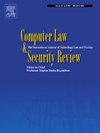Principles for the responsible application of Generative AI
IF 3.2
3区 社会学
Q1 LAW
引用次数: 0
Abstract
The quest for Artificial Intelligence (AI) has comprised successive waves of excessive enthusiasm followed by long, dispirited lulls. Most recently, during the first 3–4 years of public access to Generative Artificial Intelligence (GenAI), many authors have bought into the bullish atmosphere, replaying consultancies' predictions about gold mines of process efficiency and innovation. A more balanced approach to the technology is needed. Instances of apparently positive results need calm analysis, firstly to distinguish mirages from genuine contributions; secondly, to identify ways to effectively exploit the new capabilities; and thirdly, to formulate guidance for the avoidance and mitigation of negative consequences.
This article's first contribution is to ground the evaluation of GenAI's pathway, applications, impacts, implications and risks in a sufficiently deep appreciation of the technology's nature and key features. A wide range of sources is drawn on, in order to present descriptions of the processes involved in text-based GenAI. From those processes, 20 key characteristics are abstracted that together give rise to the promise and the threats GenAI embodies.
The effects of GenAI derive not from the technological features alone, but also from the patterns within which it is put to use. By mapping usage patterns across to domains of application, the phenomenon's impacts and implications can be more reliably delineated. The analysis provides a platform whereby the article's final contribution can be made. Previously-formulated principles for the responsible application of AI of all kinds are applied in the particular context of GenAI.
生成式人工智能负责任应用的原则
对人工智能(AI)的追求经历了一波又一波的过度热情,随后是漫长而沮丧的平静。最近,在公众接触到生成人工智能(GenAI)的头3-4年里,许多作者都加入了乐观的气氛,重复咨询公司对流程效率和创新金矿的预测。我们需要一种更加平衡的技术方法。对明显积极结果的实例需要冷静的分析,首先是为了区分海市蜃楼和真正的贡献;其次,找出有效利用新能力的方法;第三,制定避免和减轻负面后果的指导方针。本文的第一个贡献是对GenAI的途径、应用、影响、影响和风险进行评估,充分深入地了解该技术的性质和关键特征。为了呈现基于文本的GenAI所涉及的过程的描述,绘制了广泛的来源。从这些过程中,抽象出20个关键特征,这些特征共同产生了GenAI所体现的希望和威胁。GenAI的影响不仅来自技术特性,还来自使用它的模式。通过将使用模式映射到应用程序领域,可以更可靠地描述这种现象的影响和含义。分析提供了一个平台,使文章的最终贡献得以实现。以前制定的负责任地应用各种人工智能的原则适用于GenAI的特定背景。
本文章由计算机程序翻译,如有差异,请以英文原文为准。
求助全文
约1分钟内获得全文
求助全文
来源期刊
CiteScore
5.60
自引率
10.30%
发文量
81
审稿时长
67 days
期刊介绍:
CLSR publishes refereed academic and practitioner papers on topics such as Web 2.0, IT security, Identity management, ID cards, RFID, interference with privacy, Internet law, telecoms regulation, online broadcasting, intellectual property, software law, e-commerce, outsourcing, data protection, EU policy, freedom of information, computer security and many other topics. In addition it provides a regular update on European Union developments, national news from more than 20 jurisdictions in both Europe and the Pacific Rim. It is looking for papers within the subject area that display good quality legal analysis and new lines of legal thought or policy development that go beyond mere description of the subject area, however accurate that may be.

 求助内容:
求助内容: 应助结果提醒方式:
应助结果提醒方式:


